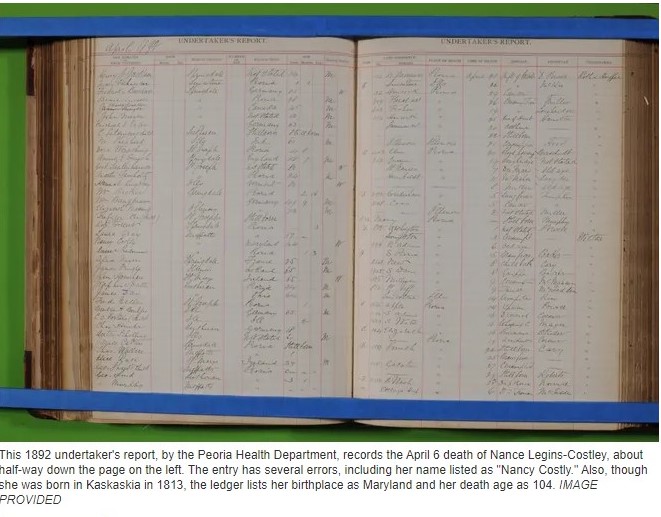PEORIA, Ill. – The name of Nance Legins-Costley could resonate amid the likes of Harriet Tubman, Frederick Douglass and other abolitionist figures.
But her story is hardly known. Not in Illinois, where – despite anti-slavery laws – she was born into bondage. Not in the city of Pekin, where – despite anti-Black attitudes – she became a beloved community figure. And certainly not in Peoria, where – despite her impressive life – she is buried in ignominy.
Perhaps her story is more subtle than those of high-profile abolitionist leaders, yet her fortitude was astounding. Barely a teen, she first stood up for her civil rights in a court of law that was stacked against Black people. Even amid legal defeats, she kept seeking the most basic of rights: freedom.

“She was a very impressive lady,” says Carl Adams, a historian who has spent more than a quarter-century researching the struggles of Legins-Costley.
She eventually won her freedom, thanks to Abraham Lincoln. But her victory came in 1841, long before the attorney became the nation’s president and more than 20 years before the Emancipation Proclamation.
Thus, Legins-Costley became the first Black person freed from bondage by Lincoln, to eventually be followed by 4 million others. Moreover, Adams and other historians say, the case pushed a theretofore ambivalent Lincoln toward an anti-slavery stance.
“This was the first time Abraham Lincoln first gave serious thought to these conditions of slavery,” Adams says.
And for all that, not only is her story relatively unknown – Legins-Costley’s final resting place is marked with no honor. Rather, it’s not marked at all. Decades ago, her graveyard in Peoria was paved over with asphalt.
Legins-Costley lies somewhere amid a muffler shop, union hall, auto garage and other commercial buildings, mostly forgotten by the march of progress, under a tombstone of asphalt.

A free state’s slaves
Illinois, the Land of Lincoln, was once the land of slavery.
After losing the Revolutionary War, Britain ceded a vast chunk of land – including what would become Illinois – to the United States. Established in 1787, the Northwest Territory forbade slavery per the federal Northwest Ordinance. When Illinois became a state in 1818, its constitution prohibited slavery.
But legislation is one thing. Reality is another. And slavery already had traction in Illinois.
In 1752, when France ruled the area, Black slaves were held by 40% of Illinois households, according to The Randolph Society, a historical organization in Randolph County in southern Illinois.
Despite the institution of the Northwest Ordinance, the territorial government did not enforce the slavery prohibition, nor did the state immediately after joining the union in 1818. What were known as “French slaves,” descendants of the area’s original slaves during the 1700s, were kept in subjugation into the mid-19th century. Meanwhile, slaves could legally be brought to Illinois from slave states for one year (but renewable) work contracts.
The territory and state also permitted a system of indentured servitude. The lengths of servitude varied by age but could extend as long as 99 years – essentially, a lifetime. Though the law implied the need for consent by the servant, the system was essentially slavery by another name. Indeed, indentured-servitude contracts (and thus the services of the servant) could be sold just like any sort of property, and without any consent necessary.
Amid this era of bondage came the arrival of a baby who would grow up to be Nance Legins-Costley.
To a large degree, her story remained unknown until the mid-1990s, when Adams first noticed a mention of her life. Adams, who recently lived in North Pekin, gradually unpeeled layers of her life, a process he continues today.
“It is a short, simple story compared to most Lincoln books, but it has made a bigger impact than I ever imagined,” says Adams, who in 2016 published “Nance: Trials of the First Slave Freed by Abraham Lincoln.”
Nance was born in 1813 in Kaskaskia, which briefly served as Illinois’ first capital. She likely was the daughter of Randall and Anachy Legins, who had been bought as indentured servants (along with two others) by Col. Tom Cox for $770.
By laws of the time, Nance could be held (or sold) as an indentured servant until age 28.
By 1820, Nance, 7, and sister Dice, 5, were already working at Cox’s Columbia Hotel. Though the state capital already had moved to Vandalia, boarders – including businessmen and other bigwig travelers – routinely would discuss issues of the day, including slavery.
And Nance, though illiterate for a lack of schooling, listened intently.

For FULL ARTICLE, CLICK HERE.
Leave A Comment